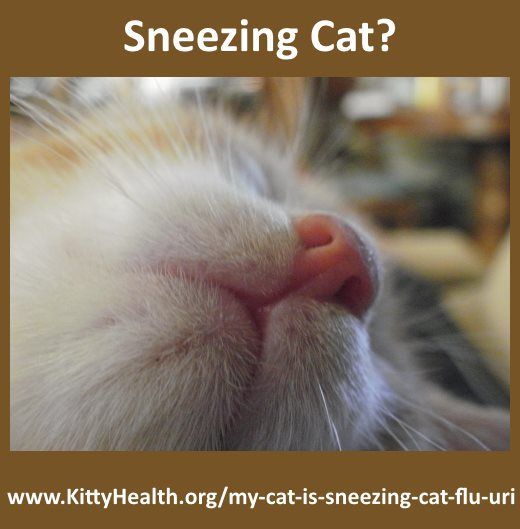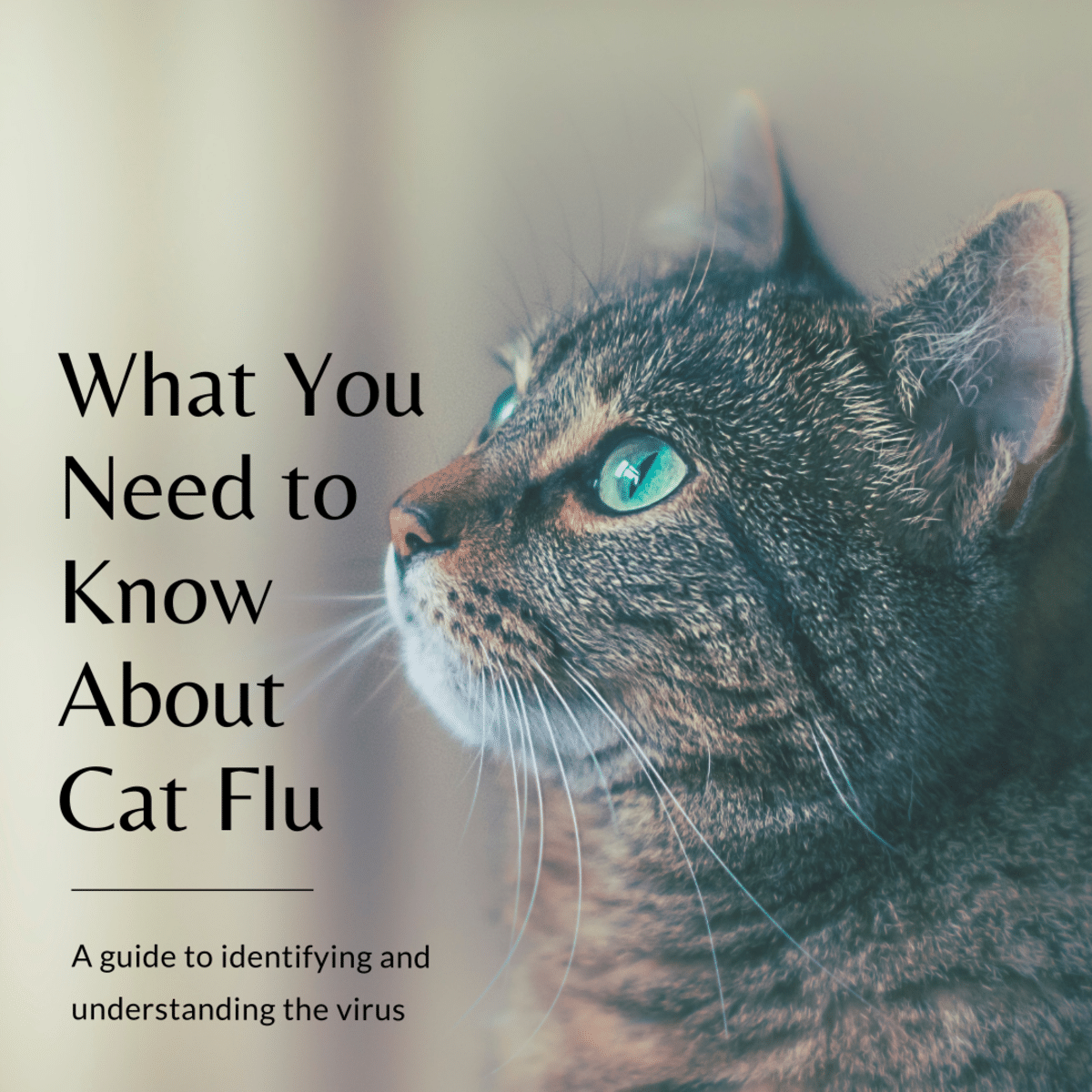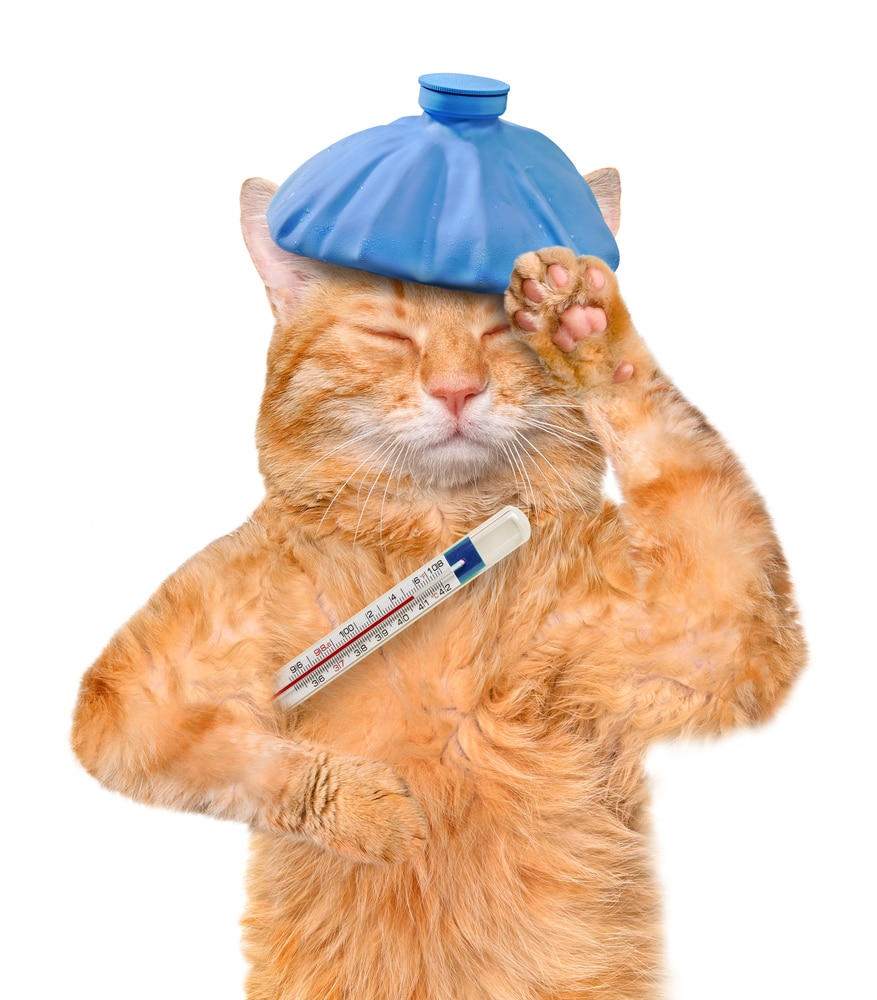What Is Cat Flu And How Is It Spread
The illness itself is normally caused by the Feline Herpes Virus 1 or Feline Calicivirus .
The disease affects the:
- eyes, nose, mouth and windpipe. In severe cases it may even spread to the lungs and bronchi.
The viruses are spread:
- Via sneezing and contact with the discharges. It can also be spread via cat food bowls, grooming brushes and bedding. In fact because some of the viruses can live for a short while outside of the cats body in the environment, it is a good idea to thoroughly clean the home environment. The use of household bleach mixed with water is advisable on washable items.
The Spread of the virus needs to be contained. The best method is to:
- Cats infected with the feline flu should be kept separate from other animals to prevent spreading the disease.
- Although humans cannot catch the disease from cats, we may inadvertently help spread it from one animal to another via our hands. It is important that we do not handle the sick cat often and always thoroughly wash our hands when we do.
My Cat Is Sneezing Is It Cat Flu
Cat sneezing can be triggered by anything that irritates your cats nose, such as cigarette smoke, air freshener, or allergies. If the sneezing isnt accompanied by other cat flu symptoms, such as runny nose and eyes, then these other irritants could be to blame. However, if youre unsure, its always best to seek advice from your vet.
What If Your Carrier Cat Does Develop Symptoms
Talk to your vet about treating symptoms when they appear, if they are minor it is unlikely treatment will be needed. However if a secondary bacterial infection develops, antibiotics may be required. We need to be mindful that weeping eyes can quickly become more severe and may cause corneal ulcers to develop on the eye. Prompt veterinary attention is necessary in this case.
Recommended Reading: What Temperature Do Cats Get Cold
Symptoms Of Feline Flu
Cat flu refers to one of several types of upper respiratory infections in cats. Although these infections are not brought about by an influenza virus, the disease is commonly referred to as cat flu because of the similarity to the symptoms of the human flu virus. Your cats flu symptoms will vary depending upon the cause and the underlying virus, but they typically include one or more of the following:
- Swollen eyes and nose
- Mouth and eye ulcers
- Pain while walking
Many of these symptoms are common to other, more serious diseases. If your pet displays one or more of the warning signs listed above, take him to a vet for immediate examination. Feline flu is especially damaging to kittens and pregnant cats, but its unpleasant for cats of all ages and breeds.
What Is Cat Flu

Cat flu is a common illness affecting the upper respiratory tract in cats, much like a cold or the flu in humans. It is mainly caused by one of two viruses feline herpes virus and feline calicivirus. Once the cat is unwell, bacterial infections can also become involved and often make the illness worse. Cats most likely to be worse affected are the very young, very old or those with a damaged immune system, as they find it more difficult to fight off infections. For these cats, catching flu can be life threatening.
It is spread much like a cold, through your cat coughing and sneezing then other cats picking up the germs. Once cats have recovered from cat flu, its possible for some cats to continue to harbour the infection and come down with cat flu again, particularly during times of stress or other illness.
Don’t Miss: Spider Plant Toxic To Cats
Diagnosis Of Flu In Cats
If your cat or colony of cats is showing signs of flu, contact your veterinarian. Your doctor will conduct a physical examination and collect a history. He or she will want to know if your cat has recently been in contact with other cats or if it was adopted from a shelter. Examination will include checking the mouth, nose, and eyes for signs of inflammation and ulcers. To check for eye ulcers, your veterinarian may use fluorescein dye. A presumptive diagnosis can be made based on the presenting signs. Most treatments will be based on the observed symptoms.
Although treatment can be started based on the presumptive diagnosis, your doctor may collect samples such as swabs around the eye or throat a cell scraping from the lining around the eye, nose, or inside the mouth or samples of the discharge from the nose or eyes. The cell scrapings and swabs can be used to help identify or culture for Bordetella, Mycoplasma, or Chlamydia, and the discharge samples could be used to test for the presence of antibodies to FHV or FCV. If your cat seems to have rapid or difficult breathing, your veterinarian may want to take x-rays to check for evidence of pneumonia.
The Symptoms Of Cat Flu
|
If you notice your cat displaying any of the following symptoms, you should take them to the vets immediately to have the illness diagnosed professionally and treated quickly.
The symptoms of cat flu can last between 7 and 14 days depending on the strain of virus. |
You May Like: When Do Newborn Kittens Start To Poop
Home Remedies For Cat Flu
1. Warm, humid air
Keep a humidifier near your cat, or take them into the bathroom with you as you shower to allow the steam to open their nasal passages.
2. Soft, strong-smelling foods
Cat flu can affect your cats sense of smell and a sore throat can make eating uncomfortable. Give your cat soft foods that have been warmed slightly to encourage them to eat.
3. Gentle face washing
Using a warm washcloth, gently wipe your cats eyes and nose to remove any secretions.
Why Do We Vaccinate
If vaccinated as a young kitten it is unlikely your cat will contract flu, as he or she will already have developed antibodies against the disease. However, if your vaccinated cat does contract flu the severity of the virus is drastically reduced.
If your cat is a carrier, vaccination is still recommended for two reasons:
1. Any symptoms that develop will be less severe.2. It is extremely unlikely that your cat would be a carrier of both FHV-1 and FCV, therefore vaccination will prevent your cat catching the other strain of flu.
Vaccinations should continue to be given by your vet once every year.
Also Check: Why Is My Cat Leaving Tiny Blood Spots
What Is A Carrier Cat’
Most cats that have been infected with cat flu enter what is called a carrier state’, where the virus remains in the system, but symptoms are not always apparent.
FHV-1 carriers are only infectious when they are shedding the virus. Viral shedding can be continual or intermittent. Carriers most commonly start shedding the virus during periods of stress e.g. re-homing, boarding, new family member, early weaning.
FCV carriers continue to excrete the virus for 3-18months after they are initially unwell. FCV carriers excrete continuously so are always potentially infectious to other cats, particularly unvaccinated ones.
Home Care For Cat Flu
Once your cat has been treated by your vet there are some things you can do at home to help them recover:
- Wipe their eyes and nose – to help your cat feel better, smell their food and breathe more easily, use a cotton wool pad soaked in warm water to wipe any discharge from their eyes and nose.
- Reduce stress – keep your cats life as stress-free as possible because stress can make illness worse.
- Help them eat – if your cat isnt eating, add a small amount of warm, smelly food to their meals . If this doesnt work try warming it slightly, make sure its not too hot and mix it well.
- Help them breathe. Help your cat break down some of the thick mucus in their airways by sitting with them in a steamy room . Dont ever force your cat into a steamy room and take them out if they seem stressed at any point.
Recommended Reading: Royal Canin Urinary Treats For Cats
Should You Let Your Vet And Boarding Facility Know If Your Cat Is A Carrier
Yes! It is important for your vet to know, as it will assist with future diagnosis and treatments. You should let your boarding facility know for the following reasons.
- To avoid any additional stress to your boarding cat – eg. Housing them away from other cats or in an environment they prefer such as in a sunny room.
- Cattery attendants can watch more closely for clinical signs, discomfort or illness before they become a problem.
- Cattery attendants can keep a very close eye on your cat’s appetite and if necessary feed more palatable foods.
- Your cat may need extra warmth from blankets and a heating pad.
For the safety of other cats:
- Cattery assistants can ensure contact with other cats is avoided.
For all of the reasons listed above it is a great idea to let your cattery know. Your flu carrying cat can be isolated so s/he can receive special attention in the cattery and other visiting friends can avoid catching this debilitating virus.
Cat Flu Upper Respiratory Infection

17th August 2018
Cat flu, or upper respiratory infection is a very common disease that can vary considerably in severity, and on occasions can even be life-threatening.
In the vast majority of cases, disease results from infection with feline calicivirus or feline herpes virus . Clinical signs include sneezing, nasal discharge, conjunctivitis , ocular discharge, loss of appetite, fever and depression. Mouth ulcers, coughing, excessive drooling of saliva and eye ulcers may also be seen. Very young, very old and immunosuppressed cats are more likely to develop severe disease and possibly die as a result of their URI, usually due to secondary infections , lack of nutrition and dehydration.
Typical ocular and nasal discharges of cat flu
Infection with feline herpes virus can cause serious eye damage
You May Like: How Old Can Kittens Eat Dry Food
How Is Cat Flu Prevented
Prevention can be achieved in most households by vaccination. As there are many different strains of the virus, vaccination may not prevent your cat from becoming infected, but will markedly reduce the severity of the disease. Even cats that have contracted cat flu should be vaccinated, as they have probably only been infected by one of the viruses so they are likely still susceptible to becoming infected with other strains.
Where possible, vaccination courses should start when the cat is 6 to 8 weeks old, and booster vaccinations should be given as recommended by your vet. Until kittens are fully vaccinated, they should be kept inside and prevented from socialising with other animals to reduce their risk.
In multi-cat households and boarding facilities, vaccination alone may not control the disease. Disinfection is important. Clinically ill or carrier cats should be isolated and fed and handled last, and their bowls and litter-trays cleaned frequently.
For more information on cat flu and the prevention of this disease, please contact your local Greencross Vets team. Alternatively, learn more about our cat vaccinations here.
The Role Of Stress In Cat Flu
Stress can play an important part in causing cat flu and also prolong the time it takes for them to heal from cat flu.The most common viral causes of cat flu can be opportunistic, meaning when your cats immune system is not as strong, the viruses will take the opportunity to make your cat sick.
There are many reasons why young kittens and adult cats alike can be stressed. Some of the most common causes include:
- Moving households
- Living in crowded or unsanitary conditions
- New people and other animals in the home
- Underlying illness- if cats are in pain or are sick for another reason, their immune system can be depressed/compromised, which can lead to upper respiratory infections
Stress is not the only reason your cat may have an upper respiratory infection, but it is worth consulting your veterinarian about your cats lifestyle and any changes at home to see if this could be a contributing factor.
Also Check: Is Friskies A Good Cat Food
How Do We Treat It
The most important thing we must do for your cat when they are suffering from flu is to support them nutritionally and ensure they stay hydrated. As cat flu is a viral disease there are no drugs to cure it, just like human flu. The viral infection will run its course â normally within 1-2 weeks. However there are things we can do to make them feel more comfortable, and there are times where it is important we intervene.
As with any feline illness, the major danger signs are that they stop eating or become quieter than usual. If you see these signs you should see the vet immediately,because cats can become dangerously dehydrated even if they are still drinking water.
Treatments include fluid therapy, antibiotics to treat secondary bacterial infections, anti-inflammatories to lower a potential fever as well as encourage eating, and decongestants to help loosen mucus.
If you have other cats at home it is important to keep them separate from your cat that is suffering from cat flu.The disease is spread by anyone or anything that has touched an infected cat âso it is very important to wash your hands before handling a healthy cat and make sure they do not share water bowls, food bowls or blankets.
Are Some Cats More Susceptible To Cat Flu
Snub-nosed cats like Persians, Himalayans and Exotic Shorthairs are particularly prone to snuffles. Furthermore, very young and very old cats tend to get much sicker if they are infected. The likelihood of serious symptoms from the illness increases when cats are not vaccinated or they have low resistance.The above refers to cats more likely to become infected or to develop more severe symptoms when they do. However, this does not mean that your healthy cat of a different breed is protected against infection. You should vaccinate your cat even if they are not in the high risk group.If one of several cats in your household gets the flu it is best to keep the sick cat isolated until their symptoms have disappeared completely. You dont have to give your other cats any preventive medication. Furthermore, people cannot get this virus and you dont have to worry about your other pets either.
Recommended Reading: How To Prevent Male Cats From Spraying
Can A Cat Be Tested To See If He/she Is A Carrier
In most cases, diagnosis of cat flu is made by assessing the clinical signs.
A test is available and needs to be conducted whilst the cat is showing clinical signs . The cats mouth is swabbed and the swab is then sent to a laboratory. There, the virus can be grown in a culture and identified. Unfortunately this service is generally not commercially available the testing is often unreliable and the whole process can be very costly.
Is There A Cat Flu Vaccine
Yes, there is a vaccine which protects against most viral strains of flu. Our advice is to vaccinate your kitten against the disease as early as possible as this is the most effective way of reducing the risk of it spreading. Cats can be vaccinated from as early as eight weeks. There are also vaccines against the bacterial forms of the illness although they are not usually given on a routine basis. You should discuss this with your daytime vet.
Be aware that flu vaccines are not always 100% effective and even vaccinated cats can become carriers of the disease without showing any symptoms. This leaves them at risk of infecting other cats.
Read Also: Flea Shampoo For Kittens Under 12 Weeks
Can Cat Flu Be Prevented
Almost every cat will have direct contact with the viruses that cause cat flu because they are so common and contagious. However, this does not mean that it will always cause illness.
A commonly used vaccine to help prevent infection with feline herpesvirus and feline calicivirus is available, although it is not always completely effective it can sometimes help to relieve symptoms. Ask your veterinarian if this is appropriate for your cat.
Cat Flu How To Treat And Prevent

Cat flu is quite a nasty illness for your pet. If you have never seen a cat with flu then count yourself lucky. It is far worse than cat colds.
Our cats have always been vaccinated and have never caught the feline flu, but because Little Mo came from an animal shelter, we did not know her previous history and she caught the flu soon after we re-homed her.
It really was sad to see, she didnt eat or drink for days. She could hardly walk and it was pitiful to hear her croaky almost silent mew.
Cat Flu is the common name given to a group of viruses, which affect the upper respiratory tract in cats.
Healthy cats are normally able to cope with the illness and it is not usually fatal, but it can be much nastier and dangerous to kittens and cats with a weaken immune system.
Anyway we all know how unpleasant the flu can be in ourselves, so it is something that we should try and protect our pets from catching it in the first place.
This is a very serious condition which can cause long term damage to some cats such as blindness. It can also kill young cats and which is why vaccination is so important.
Recommended Reading: Siberian Kittens For Sale 2021
Also Check: How Do Indoor Cats Get Feline Leukemia